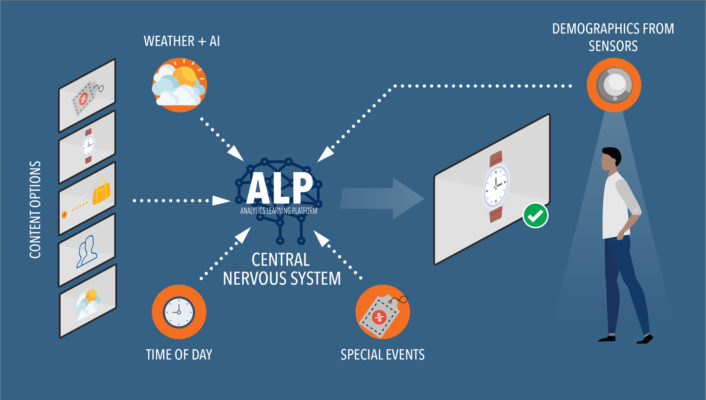AI, Digital Signage Boost Retail Sales

With in-depth analytics, online stores have long held an advantage over their brick-and-mortar counterparts. In physical retail spaces, one key metric that could help close this gap is average shopper dwell time.
Dwell time is the amount of time a customer stays in the store. This indicator can help analyze customer buying behavior to boost average spending. Reports show that an increase of only 1 percent in the average customer dwell time means a 1.3 percent increase in sales.
Beyond determining the average time customers remain inside a store, the next step would be to ascertain just how long customers stay in each area of the store. Even better would be to know which types of customers (e.g., age, gender) linger in which parts of the store and for how long:
- What is the difference between individual customers compared to couples or groups of friends?
- How does customer behavior vary with time of day, day of the week, seasons of the year, or holidays?
- What role do outside environmental conditions like temperature and inclement weather play?
This is all well and good, but how do you determine this? Sticking a time-stamped label on the backs of all visitors as they enter the store—and making a note of when they exit—would be less than enthusiastically received by customers.
In the case of a brick-and-mortar store, new technologies enable interactive displays to be mounted strategically around the store, with each display presenting advertising targeted specifically at whoever is in the vicinity at that time. Furthermore, these ads could be customized based on where visitors have already been in the store and how long they stayed in each location.
AI on the Retail Floor
NEC has developed a business intelligence solution, the Analytics Learning Platform (ALP), designed to deliver consumer insights to the retailer while also creating positive shopping experiences as described in Video 1.
Video 1. NEC’s Analytics Learning Platform highlights.
The system leverages the combination of Microsoft Azure cloud services and servers based on Intel® Xeon® technology for edge processing. ALP uses data gathered from multiple sensors (cameras, Wi-Fi Sensors, and other context-rich feeds) to engage each shopper (Figure 1).

For example, video feeds from multiple cameras can be fed to edge servers in the store. Using artificial intelligence (AI) and machine vision applications, these servers can determine the age and gender of each customer and track them as they move around the store, including how long each customer dwells in each location.
Besides providing management with data such as the amount of time customers remain in different parts of the store, ALP can also be used to deliver targeted advertising to customers as they pass by interactive displays. Furthermore, using information like weather and special events, ALP can help management by predicting the types of merchandise customers likely want to see.
The Privacy Problem
One big customer concern that has to be overcome is that of privacy. Consumers enjoy the advantages offered by targeted advertising—in particular, being presented only with products that are of interest. But there is a rising awareness of, and distaste for, data-gathering operations, coupled with an increasing desire for one’s data to remain private.
It’s important to note that all such data collected by the NEC platform is totally anonymous. The system “thinks” of customers in terms of “Person #1, Male, 16 to 20 years old” and “Person #2, Female, 45 to 55 years old.” No attempt is made to tie specific identities to this data.
In addition to increasing privacy and security, using edge processing dramatically decreases the amount of data transmitted to the cloud, while also reducing latency. Meanwhile, the anonymized, minimized data that is sent to the cloud can be processed to determine larger trends, such as the way customer behavior changes over time and circumstances.
A reporting dashboard brings all this data together, making it actionable. Real-time insights to customer behavior drive content that creates impressions through segmentation and personalization (Figure 2).

“This is where retailers can understand how a consumer is behaving and influence that behavior in a revenue-positive way, or in a more positive consumer experience,” said NEC Analytics Platform Strategist. “It provides a nice feedback loop.”
Knowing Your Customer Is the Future
It won’t be long before the idea of basing business decisions using only “average dwell time” will seem “so 20th century.” The future of brick-and-mortar stores will rely on tools like ALP to understand when people enter, where they go in the store, how long they stay, and what they purchase.
While in the store, visitors will be presented with targeted advertisements based on their age and gender, their current location, and other a they’ve already visited. And even after customers have left the store, the solution will continue to provide management with insights as to customers’ future wants and needs.
“We’re providing retailers with more data about what’s going on in their physical stores than ever before,” said Harlin. “Moving forward there are new opportunities to enable additional insights, giving store owners even greater advantages.”